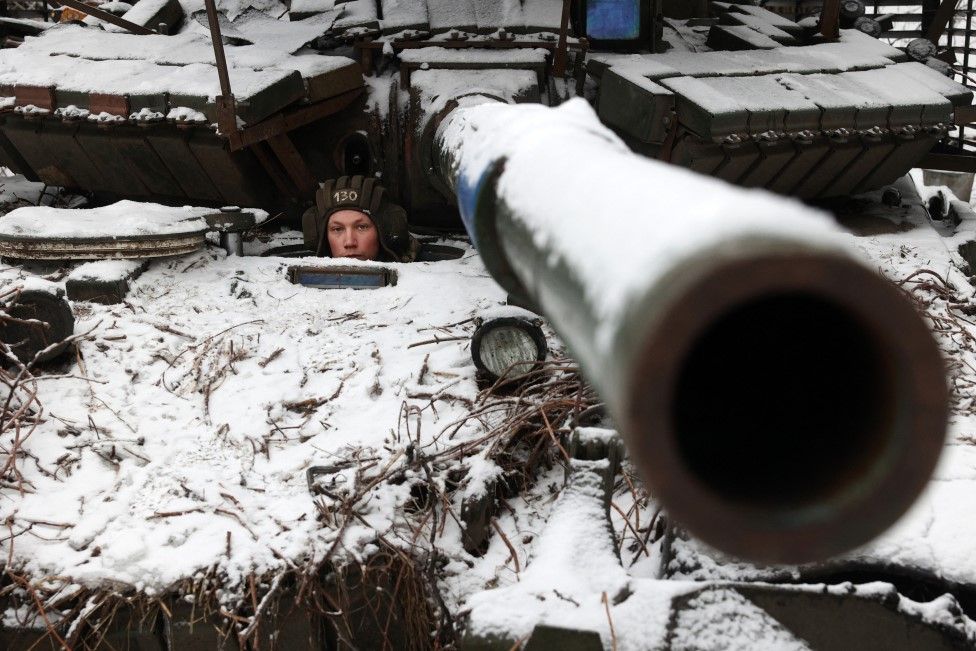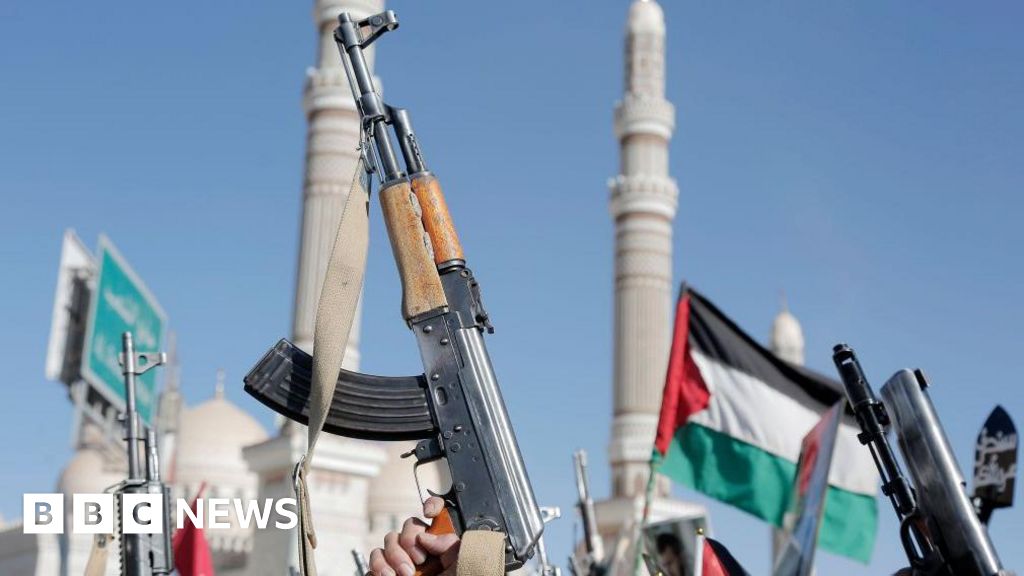ARTICLE AD BOX
 Image source, Getty Images
Image source, Getty Images
A Ukrainian soldier looks out from a tank near Bakhmut, eastern Ukraine
The conflict in Ukraine is about to enter its third calendar year. The front lines have hardly moved in the last few months but could the course of the war change in 2024?
President Volodomyr Zelensky has admitted his country's spring offensive has not been the success he hoped. Russia still controls about 18% of Ukraine.
We asked three military analysts how they think events may unfold in the coming 12 months.
War will drag on but not indefinitely
Barbara Zanchetta, Department of War Studies, King's College London
The prospects for an end of the war in Ukraine remain bleak. Compared with this time last year, Vladimir Putin is stronger, politically more than militarily.
The situation on the battleground remains uncertain. Recently, Ukraine's winter offensive seems to have come to a halt. But there is no Russian breakthrough, either. More than ever, the outcome depends on political decisions made miles away from the centre of the conflict - in Washington and in Brussels.
The West's impressive show of unity displayed in 2022, and that endured throughout 2023, is starting to vacillate.
The US defence aid package is held hostage by what President Biden rightly labelled "petty politics" in Washington. And the future of the EU's economic aid is seemingly dependent on Hungary's incongruous stance.
Hesitation in the West's capitals has emboldened Putin. His recent public appearances and defiant statements demonstrate that as far as he is concerned, Russia is in this for the long haul.
Image source, Getty Images
Image caption,Vladimir Putin in his state residence outside Moscow (file image)
So, will the West have the strength and stamina to continue to oppose him and all that he represents?
The EU's decision to open membership talks with Ukraine and Moldova is more than just symbolic. It implicitly means continued backing for Kyiv, as a future in the EU for Ukraine would be impossible with a full-blown victory for Russia.
In Washington, a complete reversal of policy is unlikely.
While it is tempting to depict doomsday scenarios for US assistance as Trump's ratings rise in the polls, the former president, amid all the theatrics, did not walk out from Nato in 2016. And he would not singlehandedly be able to revolutionise America's 75-year-long transatlantic partnership.
This is not to say that the recent cracks in the Western camp are meaningless. For the West, and therefore for Ukraine, 2024 will be more difficult.
For democracies, long-term consensus in support for war has always been more complicated than for autocrats with no accountability.
While it is likely that the war will drag on throughout 2024, it cannot drag on indefinitely.
With Western hesitancy bolstering Russia, and in the absence of either a coup or a health-related issue leading to Putin's demise, the only foreseeable outcome will be a negotiated settlement that for now both sides continue to refuse.
The course of war in 2024 will be determined elsewhere
Michael Clarke, former director general of the Royal United Services Institute
The Russian invasion of Ukraine in 2022 saw the return of major war to the European continent. The course of the conflict in 2023 marked the fact that industrial-age warfare had returned too.
Industrial-age warfare bends significant parts, or in some cases whole economies, towards the production of war materials as matters of priority. Russia's defence budget has tripled since 2021 and will consume 30% of government spending next year.
This will make the war in Ukraine a longer and more traumatic enterprise than anything Europe has known since the middle of the last century. The coming year will demonstrate whether Russia - and its suppliers in North Korea and Iran - or Ukraine - and its Western backers - are able and prepared to meet the voracious demands of industrial-age warfare.
Image source, Getty Images
Image caption,Paramedics evacuate an injured elderly woman after a cluster bomb strike in Kramatorsk, eastern Ukraine
It would be wrong to say that the front lines in Ukraine are stalemated, but both sides are capable of fighting each other to a standstill as they each try to take strategic initiatives.
Russian forces may try to push again along the entire front, at least to secure all of the Donbas region. Ukraine will probably try to exploit the success it has had in re-establishing its control over the western Black Sea and its vital trade corridor to the Bosphorus.
And Kyiv will likely also try to spring more military surprises on the Russian invaders to knock them off-balance in some areas.
But in essence, 2024 looks like being a year of consolidation for both Kyiv and Moscow.
Russia lacks the equipment and trained manpower to launch a strategic offensive until spring 2025, at the earliest.
Image source, Getty Images
Image caption,A Ukrainian soldier uses a grenade launcher in the direction of Avdiivka at the frontline in Donbas
Meanwhile, Ukraine needs Western finance and military support to keep it in the war during next year while it, too, builds up its intrinsic strengths to create the conditions for a series of liberating offensives in the future.
Industrial-age warfare is a struggle between societies. What happens on the battlefield becomes ultimately only the symptom of that struggle.
The military course of this war in 2024 will be determined in Moscow, Kyiv, Washington, Brussels, Beijing, Tehran and Pyongyang more than in Avdiivka, Tokmak, Kramatorsk or any of the devastated battlefields along the frontlines.
US fighter jets could make a difference
Ben Hodges, former commanding general, United States Army Europe
Russia lacks a decisive, breakthrough capability to overrun Ukraine and will do what it can to hold on to what it currently occupies, using the time to strengthen its defences while it hopes for the West to lose the will to continue supporting Ukraine.
But Ukraine will not stop. It is in a fight for its survival and understands what Russia will do if it stops. More European nations are now talking about the need to step up aid in light of concerns that the US is weakening in its resolve.
Image source, Getty Images
Image caption,Presidents Biden and Zelensky during the G7 summit in Hiroshima in May
I do, however, anticipate that early in the new year the US will rediscover its strategic backbone and pass the aid package that was delayed in Congress in December.
Therefore, I anticipate Ukraine will do the following in the coming months as it prepares to regain the initiative:
- reconstitute units which have been worn down from months of fighting, which will be necessary for a renewed offensive
- improve the recruiting system within Ukraine to maximise available manpower
- increase production of ammunition and weapons
- improve its ability to operate against strong Russian electronic warfare capabilities - jamming, intercepting, locating.
By early summer Ukraine will be able to use US-made F16 fighter jets for the first time, which it hopes will improve its ability to counter Russian aircraft and strengthen its own air defences.
The most strategically important part of Ukraine that remains occupied by Russia is Crimea, which is what we call the "decisive terrain".
Ukraine will do all it can to keep pressure on the Russians there to make it untenable for the Russian navy in Sevastopol, the handful of air force bases there and their logistics base at Dzankoy.
They have already proven the concept. With just three UK-provided Storm Shadow cruise missiles, they have forced the commander of the Black Sea Fleet to withdraw a third of his fleet from Sevastopol.
The Ukrainians do not have unlimited resources of course, especially artillery ammunition and long-range precision weapons.
But the Russian soldiers are in worse shape. War is a test of will, and a test of logistics. The Russian logistics system is fragile and under continuous pressure from Ukraine.

 1 year ago
20
1 year ago
20








 English (US) ·
English (US) ·